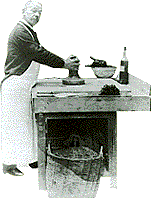It has all these qualities if mixed correctly.
Furthermore it can be made to be spread as thin as gossamer or as thick as clay.
All this depends on just two things:
a) The thinness or thickness of the paint, called its viscosity
b) The implement you decide to use to push it around - knife, brush, stick,
trowel.
So what sort of mud or paint will we make, how dry or how runny?
Oil paint is made up of three main elements.
1. Pigment a powder made from ground rock or earth or root anything
dry that is intense in color.
2. Oil (medium)
3. A drier of some sort as oil sometimes takes too long (a thinner)
 |
You can try this:
Go to the kitchen and get a little powdered saffron, powdered red
food or cocoa and add a little oil (sunflower, poppy, walnut, safflower, it dosen't really
matter which) and mix it up with a knife or spoon. You have now produced
a genuine oil paint ( and unlike many others, one you could eat it without
harm). Find some zinc cream (used as a sunscreen) in the bathroom cabinet and now you have a white oil paint - now some black boot polish and you have a decent black oil paint.
If it is a little thick or hard to mix you may add a
little turpentine, thinners or petrol which will obviously cause it to mix easier
and dry faster.
|
Note: it is usually the chemical
pigment or the thinners that causes the extremely poisonous nature
of most commercial oil paints (lead, cadmium and arsenic are old culprits). If the
powder you use is unusually strong you might be tempted to add a filler to bolster
up the mixture. This could be chalk or ground marble or some other neutral
powder. Student oil paints usually have more filler than Artists' brands.
Filler is cheaper than pigment so you get what you pay for!
 |
OK, so now what do we do with our mixture? If
we had two lumps of ‘mixture’ (paint) say a red and a yellow and made them
very oily and put them side by side on a flat surface they would gradually
spread out and merge and take ages to get dry.
So more oil will help paint to blend and merge as oil is also the lubricant
for the pigment and helps it slide around on the canvas. |
How can we reverse this and stiffen up the
paint?
We could add more pigment or filler, or we could get rid of some of that excess oil.
How do we remove the oil? By putting the mixture on blotting or
absorbent paper and waiting. The paper will absorb the oil and
a little of the pigment. Obviously to make it more runny we could add more
oil and to dry faster and spread thinner we could add turpentine, thinners
or petrol.
Get the general idea!
 |
One more thing - we can also add other things
that are mixable with oil like certain resins and varnishes
which will make the mixture sticky and shine and maybe dry in a layer like
a clear plastic sheet. This might allow what is underneath to shine through.
And when we add a little strong pigment to this sheet we can maybe make
what is called a ‘glaze’. Then again we could add some egg yolk for a 'matt' type finish. |
What now?
Like a potter you have now made you clay, only in your case it is called
paint. Instead of water you have added oil and some pigment and, instead
of a wheel, you will be putting your mixture on a flat vertical surface,
although you will mix it on a bench or pallet. There is no rush with your
paint though - it is oil based and will mostly take a long time to dry and this you know you can control adding oil or white spirits.
One main point before you apply your paint; if you first apply a thick
layer of paint to your canvas it will take ages to dry because the oil
will have to dry out. If you have ever watched oil dry out you could probably
also hear you own hair growing. When thick paint dries it shrinks and sometimes
cracks. So if your first layer of paint is very thick and you add a thin
layers on top of it before it is totally dry it will crack all the
layers applied thereafter - and as it continues to dry the cracks will get bigger
- especially if the color on top is darker.
Painters prevent this by painting the thick slow drying layers last and
usually begin with thin fast drying paint - as their background.
'Thick over thin and light over dark' is an old painters saying.
If we don’t want to wait we can paint what is called 'wet in
wet'. That means putting wet layers of paint on other wet layers all
in the one session (or over the total time it takes the paint to dry).
There can still be hours - or days until a ‘skin’ forms.
This is an important point as many painters would like to finish their
painting quickly and are thereby forced to paint 'wet in wet'.
STUDENT ACTIVITY: See next lesson. Using someof the pigments, and oils I have mentioned make up a pallet of colors and paint a small picture. Allow 40min.
GO TO ... OILS CONTINUED
... or lesson menu
|